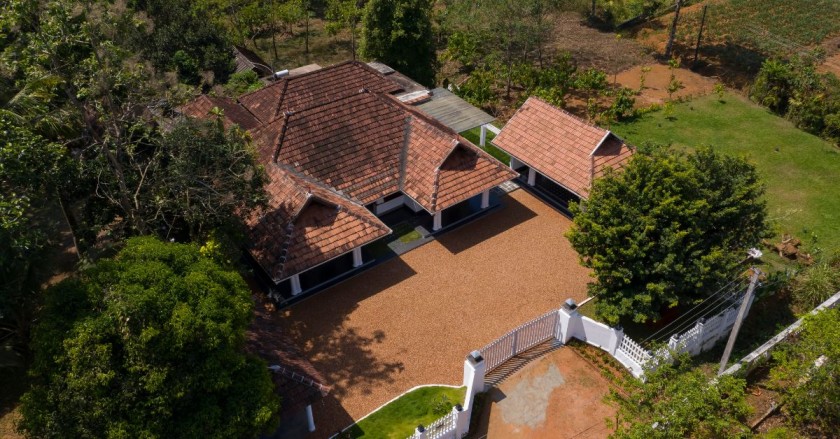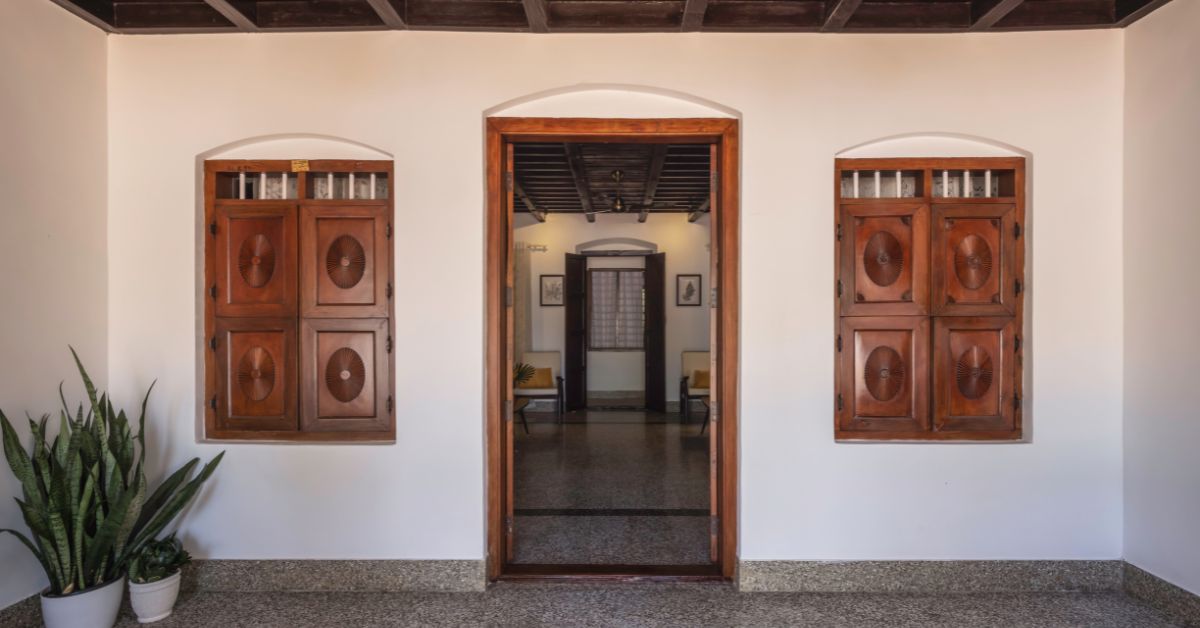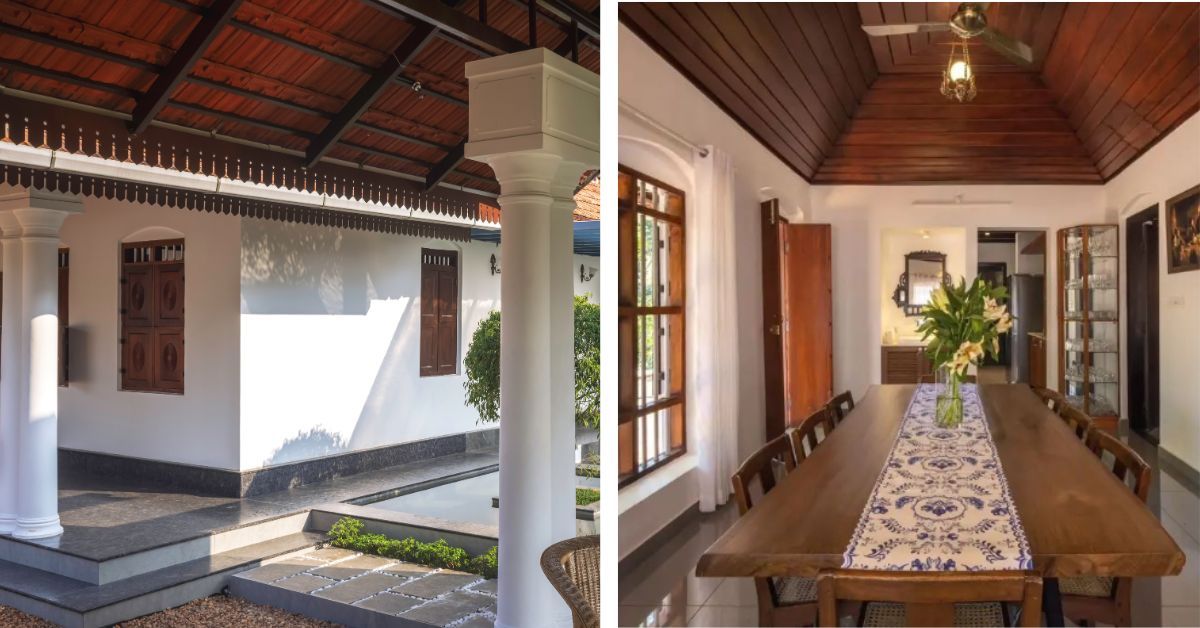Nestled in between cocoa plantations and greenery with no houses seen within a mile, Anupa Kurian grew up in a green oasis. For most of her childhood, she grew up in a traditional Kottayam-styled home.
Laced with Mangalore tiles and traditional architecture, the house, as per Anupa, “has a soul that needs to be kept intact.” So when the time to renovate the 100-year-old residence came, Anupa, an architect and designer, knew where to look for inspiration.
“I knew I was not going to bring it down and make it modern but incorporate modern amenities while keeping the authenticity of the house. I did not have to look anywhere for inspiration, the bones and structure of the house were inspiration enough,” she says in a conversation with The Better India.
When you step into the house today, everything around you changes. It isn’t 2023 anymore, but you are transported back to the early 1900s. Everything from the flooring and the house’s layout to the furniture gives a glimpse of the bygone era.
Modernising the house while preserving its authenticity
Born and raised in Kottayam, Kerala, the 31-year-old says, “Even as a kid, I was very attracted to designing things and repurposing old objects. This interest later flourished into a passion.”
After completing her graduation in design, Anupa moved to the UK to get a master’s degree.
“I love nature. I have always been inclined towards sustainable living and design. So doing a master’s in sustainable design looked like the right choice for me,” she notes.
Having worked in the field for a while now, when it came to renovating her own house, she was sure about two things — to keep the house as authentic as possible and use sustainable means to do so.
Today, sitting on a 3,000 sq ft area, Pullolickel Veedu is an outstanding example of sustainability and traditionality.

“While the house was in good condition, we wanted to give the house a facelift. I also wanted to make it adapt to the newer lifestyle,” she says.
“The house originally did not have a library space and a garage, but my grandfather and father added them as our family grew. The garages were acting as a wall between the greenery and the plantation. I decided to pull it down and make it an open patio space,” she says adding that this was the only major change she has done to the house.
Upon entering the house, you will be greeted by a lavish dining area made by restructuring two smaller rooms.
“Most of my learning came from the building itself. I did not have to refer to any other properties for the design,” she shares.
“The house has a lot of windows that flood light in; my father never used bulbs and lights during the day. I wanted to keep that intact. I added a few more windows to utilise the sun to the fullest,” she says.
“It also has a very strong foundation with mortar bricks. I did not want to touch them as they were the foundation of the building,” she says.
“Whenever I saw the house, I always thought about how many man-hours must have gone into making it 100 years ago. The skill and masonry must be preserved, and therefore, when I decided to pull down the garage, I used manual labour,” shares Anupa.

“It would have taken a JCB just minutes to break the place down, but all the bricks would have gone to waste. Because of using manual labour instead, I was able to use those bricks in constructing some of the extensions in my room and the patio,” she adds.
“While my father was against removing the garage and constructing a patio, presently he is the one who uses it the most!” she laughs.
Another example where Anupa chose to keep the originality of the house is with the roof rafters.
“The house was built using wooden rafters and most of the people advised us to change it to steel. However, on inspection, I found that the roof was stronger than ever. I decided to go against all that advice and kept the original rafters,” she explains. Today, the wooden rafters give the house a rustic and more traditional look.
Championing sustainability during renovation
Anuja further shares that to keep the house cool during harsh summers, she made two water bodies on the northern side of the house to help cool the wind that enters her home.
To make the house more sustainable, Anupa also added water gutters on the roof to use the rainwater. “The water from the gutters flows into the two ponds that we have, and we also store it to use the water for landscaping the house. Although my parents did not understand the need for the gutters, I wanted the house to be as sustainable as possible,” she says.

Despite encountering some opposition due to its divergence from current trends, she has chosen to preserve the original mosaic floors of the house.
“It looked old and was losing its charm. Most of my family and friends suggested that we change it but I wanted to preserve it. I got it polished and renewed. We got a lot of feedback from my friends and family later, and most of them loved it,” she says.
“Revival of old materials is something that I wanted to do with this house. We have used a lot of old furniture lying in the garage to make new furniture. My bed, for instance. Also, the new windows were made using the wood from the old windows,” she says.
Most of the substances used in the renovation of the house are recycled and upcycled materials. “Upcycling and recycling the materials while refurbishing the house helped us save a lot of money. Most of our family and friends speculated the cost to be around Rs 70 lakh when we started and advised us to construct a new house instead. However, I told them I will bring down the cost simply by reusing things,” she shares.
And that is precisely what Anupa did, and she was able to renovate the house fully for just Rs 30 lakh, she informs.
To blend their home even more with nature, Anupa says they have a variety of trees. “We have mango, coconut, chikoo, jackfruit, and gooseberry trees surrounding the house,” she informs, adding that they also have fish in one of the ponds in the house.
Joking about how the house looks now, Anupa recalls, “My father, on completion of the house, told me that our house used to look 50 years old, but now, it looks 150 years old! This, to be honest, is the biggest compliment I have ever gotten.”
Edited by Pranita Bhat
No comments:
Post a Comment